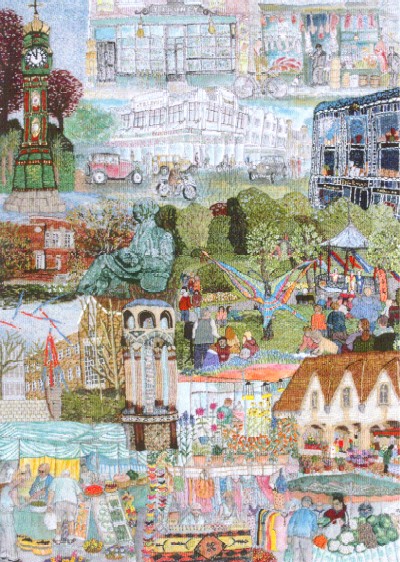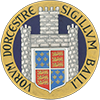Dorchester 700 Tapestry
The Dorchester 700 Community Tapestry was designed by Suzanne Finch and embroidered, painted and quilted by local volunteers and children from Dorchester's middle schools.
It was created to mark the 700th Anniversary in 2005 of Dorchester's recognition as the County Town of Dorset in the Charter of King Edward I.
It was executed between September 2005 and December 2006 and is on permanent display in the foyer to the Corn Exchange; it can be seen whenever the building is open.
Please see below the seven individual panels which make up the Tapestry.
Inside Dorchester's massive Neolithic wood henge, Iron Age people are busy weaving woollen cloth. Roman soldiers defeat local tribes at Maiden Castle and build the town of Durnovaria with villa, shops, market and fountain.
Upper left is the Woodhenge, built approximately 2000 BC. It is over a mile in length; its full extent was revealed when the car park below Waitrose was built. The tree trunks are over one metre in diameter and only one metre apart, so there was probably a palisade. The Autumn Festival is in progress!
Next on the right, Iron Age home life is represented, including textiles
The lower left shows the Roman burning of Maiden Castle, where a Celtic skeleton, now in the Dorset County Museum, was found.
To the right is the reconstruction of the best-excavated villa with an imaginary town scene, featuring shops, a market and a fountain.
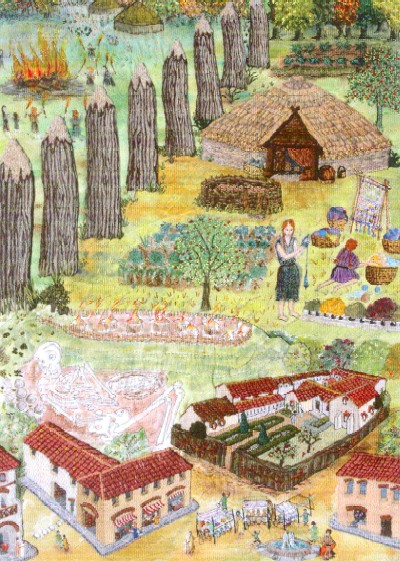
Roman Durnovaria decays in Saxon Dorchester. The town's Reeve is murdered by Viking traders when he demands income tax from them. A royal charter is granted to enable building of the prison. This scene is later re-created by Community Players for the Dorchester 700 celebrations.
Upper left shows the destruction of the Roman town
Upper right represents the unfortunate moment when the Saxon Reeve of Dorchester decided the Viking traders at nearby Chickerell should pay income tax and was killed. This was the first recorded violence by Vikings on the British mainland.
Beneath are the medieval town and its Franciscan Priory. The scene is a fictitious version of the celebrations when Dorchester was granted its charter to build a prison which effectively confirmed its status as county town.
The scene shows community players, dancers and musicians from the Dorchester 700 celebrations held at Maumbury Rings in 2005.
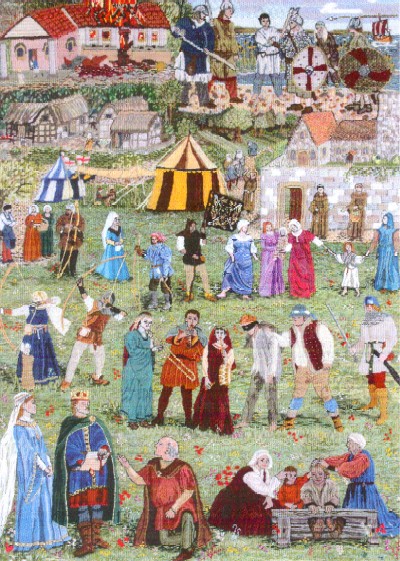
The Chideock Martyrs are executed for their faith - statues by Elisabeth Frink. Fire strikes the town in 1613 - design by St Osmund's Middle School pupils. Puritan Rector John White founds the Nappers Mite Almshouses and Grammar School, and sends a Pilgrim ship to the New World.
Top left represents Elisabeth Frink's statues of two Elizabethan Catholic martyrs facing Death. The statues are in South Walks, near the site of the old gallows.
The Great Fire of 1613 destroyed much of the largely wooden medieval town. Pupils from St Osmund's Middle School designed the fire.
Dorchester has been altered rather than rebuilt and the town holds layers of hidden history in many of its buildings.
Puritan Rector of Dorchester, Reverend John White founded the Nappers Mite Almshouses, the Boys Grammar School and girls schools. He arranged for one of the first Pilgrim Fathers' ships, the Mary and John , to sail to the New World.
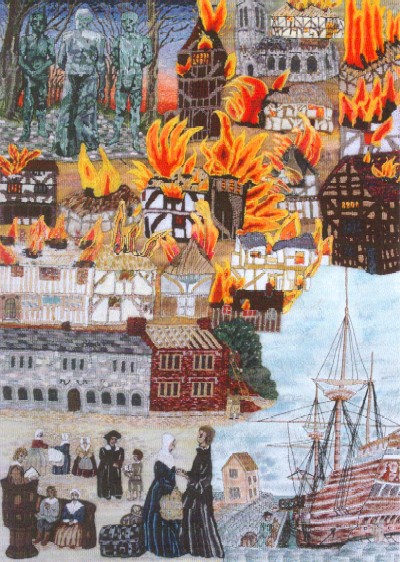
Monmouth Rebellion prisoners are marched to Dorchester gaol before appearing before Judge Jeffries at the Bloody Assizes. The town pump and Grey's Bridge are built. Nat Searle and his pet sheep Caroline are seen around the town. Planting starts in the North Walks.
This begins with the earliest known illustration of Dorchester's gaol, to which the Monmouth Rebellion prisoners were taken during the notorious Bloody Assizes. The gallows, Judge Jeffries in chambers and his lodgings are all shown in the top section.
The rest of the panel shows the new Grey's Bridge and, below that, High East Street which has changed very little since this time. The Town Pump was built and a lively market surrounded it. Nat Seale and his pet sheep Caroline were often to be seen in the Town!
Much of Dorchester was rebuilt or renovated, including two new prisons, one of which is shown at the bottom left. The town began to plant its famous walks of trees.
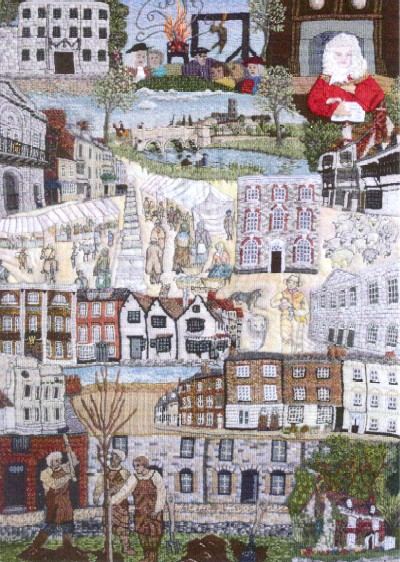
Dorchester's distinctive nineteenth century architecture, depicted in this panel designed by Year Six students from Dorchester Middle School, is still a lively and powerful presence in the town.
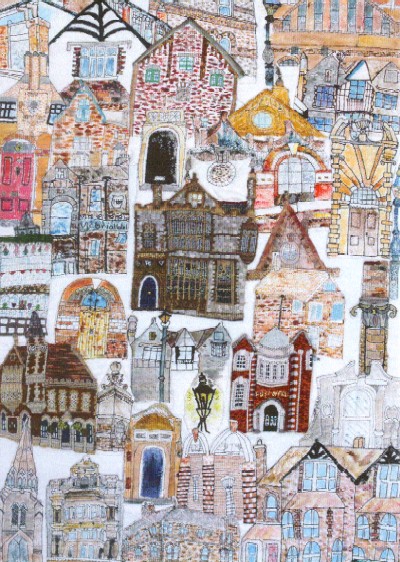
The Tolpuddle Martyrs are transported for forming a union. Cholera in Fordington leads to campaigns by Reverend Henry Moule and Sarah Eldridge to improve conditions. The existing prison is built. Dorchester's Walks are at their finest. Steam engines and agricultural equipment are built in the town.
The Tolpuddle Martyrs' story forms the first part of this panel. The tragic outbreak of cholera in Fordington brought to light the devastating poverty of much of Dorchester.
Reverend Moule and Sarah Eldridge led campaigns to improve conditions. Moule's ‘patent earth closet' was an invention that saved many lives and Sarah's work led to the building of the hospital (centre).
Part of Dorchester Barracks, The Keep and the new prison were built in this century and the Town Walks were at their very best.
Dorchester was home to some of the biggest manufacturers of steam engines and agricultural equipment in the south of England.
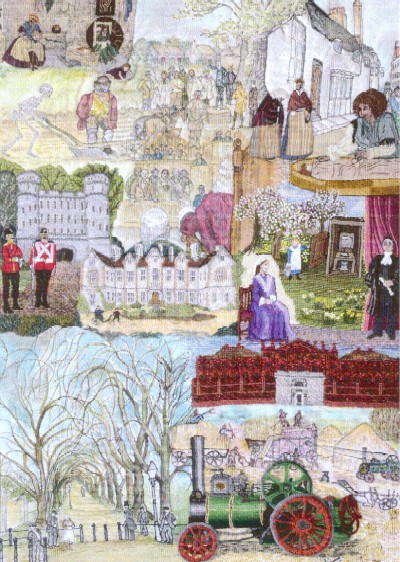
Thomas Hardy is remembered with a statue near County Hall. The town grows with distinctive shops and markets. The Borough Gardens, created in 1896 and renovated in 2007, are a venue for Dorchester Festival. Poundbury, symbolised by the Brownsword Hall, brings further expansion.
In the last century Dorchester has built and lost many spectacular commercial buildings, some of which are seen here.
The Borough Gardens, created in 1896 and renovated in 2006-07 is a regular venue for community events such as the Dorchester Festival.
Thomas Hardy sits by County Hall and Dorset County Hospital. The town fountain was built in 2000.
One of the most colourful and enduring aspects of Dorchester is the weekly market.
The expansion of the town is represented by views of the Brownsword Hall and Poundbury Farmers Market.
